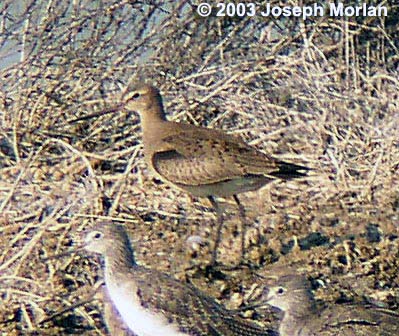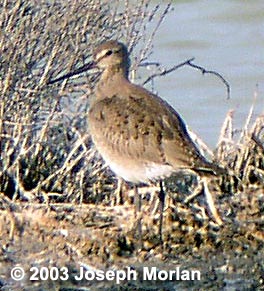Hudsonian Godwit (Limosa haemastica)
Alviso, Santa Clara County, California
29 August 2003
Joseph Morlan
Photos © 29 August 2003 by Joseph Morlan. All rights reserved.
Today I learned that a Hudsonian Godwit had been identified at the pond just east of State and Spreckles
streets in Alviso. Apparently the bird was first seen 27 August by Dean Manley, studied again the next day and
the identification confirmed this morning. I left Pacifica about 3pm arriving at Alviso about 4pm. The bird was
already under observation when I arrived. It was on a small island in the shallow pond just east of the foot of
State Street. Unfortunately it spent over 95% of the time asleep, with its head tucked in, making it difficult
to photograph. I remained until 7:30 pm and these are the best photos I was able to obtain.
Additional birders arrived gradually, including Scott, Linda and Ryan Terrell, Richard Ferrick, Siobhan Ruck,
David Nelson, Matt Brady, Vivek Tawari, Kathy Robertson and others whose names I didn't get. Several people attempted
to digiscope this bird.
I concentrated on photography, but did manage to take some notes. The following is based on notes written while
watching the bird and on the photos:
It was basically a gray-brown colored godwit with long black primary projection. It was the only godwit present
and was decidedly larger than most of the numerous other birds that were roosting on this small island. Other species
seen associating loosely with the godwit included Long-billed Dowitchers, Greater and Lesser yellowlegs, Black-necked
Stilts, Wilson's Phalaropes, and Least an d Western sandpipers.
d Western sandpipers.
Plumage-wise, it most closely resembled a juvenile Willet (this species was not present), especially when sleeping.
However, when it took its bill out, you could see some pink coloration at the base of the mandible. This was especially
evident when the bird was facing away and it was possible to see the lower mandible from below. The bill was relatively
straight, but did turn up slightly. It was quite thick at the base and tapered to a sharply pointed tip.
The head and face were gray brown with a white supraloral stripe extending to the eye and projecting only slightly
behind it. Directly above the eye a dark wedge was sometimes visible breaking the supercilium into two parts. A
dark lore stripe extended from the dark eye all the way to the base of the bill, but was not evident behind the
eye. The forehead was slightly darker than the crown, but the bird did not show a strongly capped appearance. The
flanks were gray brown, blending with the white belly and undertail coverts.
The upperparts and breast were a uniform gray-brown with some rusty tips visible on the scapulars and wing coverts.
These rusty-tipped feathers also shows blackish subterminal spots. The lesser and marginal coverts were a very
dark, blackish color. The long black primary projection was also quite noticeable and helped distinguish the sleeping
bird from a Willet. When it preened it was possible to see the tail pattern which showed a white rectangle at the
base of the tail contrasting abruptly with a broad black subterminal band. However, the very tip of the tail was
narrowly white. Once the birds were flushed by a Northern Harrier. In flight the wings showed a strong white wing-stripe
that contrasted with black flight feathers and underwing coverts creating a very striking pattern.
The legs appeared dark gray, or blackish under some lighting conditions.
Discussion
The plumage of this bird is consistent with juvenal plumage although photos seem so show a few basic scapular
and nape feathers.
There are 18 previously accepted records of this species in California, 10 of which have been juveniles in Fall.
My only previous experiences with this species in California were a juvenile at the Salinas River mouth in September
1988 and another juvenile at the Sunnyvale Water Pollution Control ponds in September 1990.
Updates
Birders visiting this site the next day (30 August 2003) found a 2nd juvenile Hudsonian Godwit. A photo by David
Vander Plym of both birds together is in our photo gallery here.
Luke Cole has posted additional details, sketches, photos, and a complete list of previous California records here. Eric Preston has posted some better images showing the
rump and the wing slightly spread here. Adam Winer posted
additional closeups of one of the birds here.
Mark Eaton has a detailed description and photos here.
The bird was missed after September 1st, but both were seen again and photographed by Jean Myers on Sept. 6th.
Excellent photos here.
Robbie Fischer and I looked for the birds on Sept. 7th without success.
 d Western sandpipers.
d Western sandpipers.